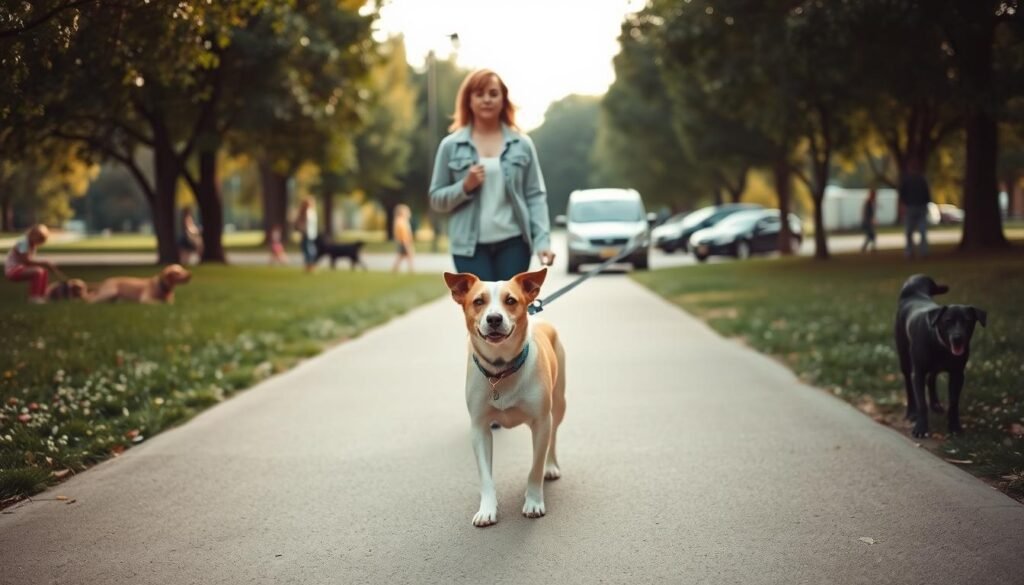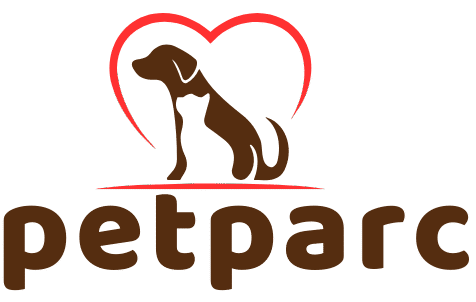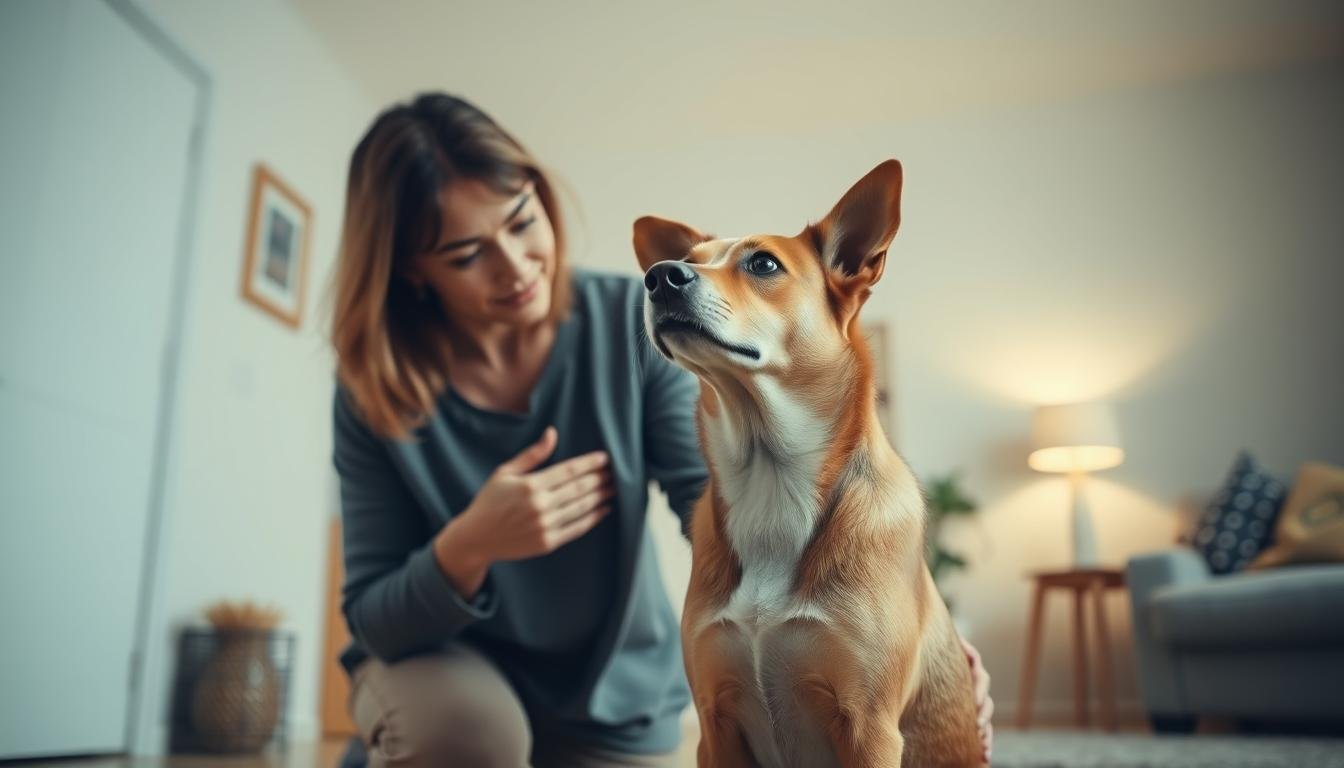What Does Reactive Dog Mean: Solutions for Managing Aggression and Fear
Table of Contents
Dealing with a reactive dog can be tough and emotionally draining. If your dog shows aggression or fear, you’re not alone. About 40% of dogs face fear-related behaviors at some point.
Managing a reactive dog needs patience, understanding, and the right training. This article will show you how to tackle your dog’s reactivity. It aims to make your home safer and more peaceful for everyone.
Understanding why your dog behaves this way is key. With the right strategies, you can greatly improve their Petrograd behavior and happiness.
What Does Reactive Dog Mean? Understanding the Behavior
As a dog owner, it’s key to grasp the concept of reactivity in dogs. This behavior is when dogs react strongly to certain things like people, other dogs, or sounds.
Defining Reactivity in Dogs
Reactivity shows when a dog overreacts to something, like barking, lunging, or growling. It’s important to know that reactivity isn’t the same as being aggressive or vicious. It means your dog feels scared or threatened.
Some common signs of reactivity include:
- Pulled-back ears
- Tail tucked between legs
- Barking or growling
- Lunging or pulling on the leash
Difference Between Reactivity and Aggression
Reactivity and aggression are different, even though they can look similar. Aggression is when a dog wants to harm someone. Reactivity is more about defending itself from a perceived danger.
Knowing the difference between reactivity and aggression helps you manage your dog better. By understanding why your dog behaves a certain way, you can make a safer, happier space for both of you.
Common Triggers for Reactive Dog Behavior
Finding out what makes your dog react is a big step. It helps them stop being aggressive or scared. These reactions often come from things around them and how they interact with others.
Environmental Triggers
Many things can set off a reactive dog, like loud noises and new places. Even smells and sights can cause a reaction. Knowing what triggers your dog helps you find ways to calm them down.
Social Triggers
Interactions with other dogs, people, or certain groups can also trigger a reaction. Dogs might feel scared, want to protect, or remember past bad experiences. Knowing what social situations upset your dog is key to safe interactions.
Understanding what triggers your dog helps you start reactive dog training. It’s a big step towards better behavior for your dog.
Signs of a Reactive Dog: Recognizing the Problem
It’s important to know the signs of a reactive dog to manage their behavior. A reactive dog might act in ways that confuse or scare their owners. But, by understanding these signs, you can start to fix the problem.
Physical Signs of Reactivity
Reactive dogs show certain physical signs. These include:
- Tensing up or becoming rigid
- Dilated pupils or a fixed stare
- Raised hackles or a stiffened posture
These signs mean your dog is stressed or feels threatened.
Behavioral Indicators
Reactive dogs also show specific behaviors. These can be:
- Barking or growling at triggers
- Lunging or pulling towards the stimulus
- Avoidance behaviors, such as turning away or hiding
By spotting these behaviors, you can understand your dog’s reactivity. Then, you can start to manage a reactive dog better.
The Root Causes of Dog Reactivity
Reactivity in dogs often comes from deeper issues. It’s important for dog owners to understand these causes. This knowledge helps in managing their dog’s reactivity.
Fear and Anxiety
Fear and anxiety play big roles in dog reactivity. Dogs may react as a defense when they feel scared or anxious. Identifying the sources of fear and anxiety is key to helping your dog.
Past Trauma
Past traumatic experiences can cause reactivity in dogs. Dogs may react to protect themselves from future harm. Gradual exposure to triggers in a controlled way can help.
Lack of Socialization
Lack of socialization is another big factor. Dogs not socialized well may react to new situations, people, or animals. Early and ongoing socialization is crucial to prevent reactivity.
| Root Cause | Description | Potential Solution |
|---|---|---|
| Fear and Anxiety | Dogs become reactive due to fear or anxiety triggered by various stimuli. | Desensitization and counter-conditioning techniques. |
| Past Trauma | Traumatic experiences lead to reactive behaviors as a defense mechanism. | Gradual exposure to triggers in a controlled environment. |
| Lack of Socialization | Inadequate socialization results in reactivity to new or unfamiliar stimuli. | Proper socialization from an early age, ongoing socialization. |
Assessing Your Dog’s Reactivity Level
To manage your reactive dog well, you need to know their reactivity level. This knowledge helps you choose the right training and management approach.
The Reactivity Scale
The reactivity scale is a helpful tool for measuring your dog’s level of reactivity. It shows how your dog reacts to different things, from low to high.
- Low Reactivity: Your dog might bark a little or growl slightly.
- Moderate Reactivity: They might lunge or bark more aggressively.
- High Reactivity: In severe cases, they could bite or show intense aggression.
When to Seek Professional Help
If your dog shows moderate to high reactivity, get professional help. A certified dog trainer or behaviorist can create a plan just for your dog.
Creating a Management Plan for Your Reactive Dog
To help your reactive dog thrive, you need a tailored management plan. This plan should address their specific needs. It outlines how to handle their reactive behavior in different situations, ensuring their safety and well-being.
Setting Realistic Goals
Setting realistic goals is key to a successful management plan. Identify what you want to achieve, like reducing your dog’s reactivity or improving their calmness. Start with small, achievable goals and build upon them. This keeps you motivated and tracks your progress.
Safety Measures and Equipment
Safety is your top priority when managing a reactive dog. This includes choosing the right equipment and creating a safe environment. Proper equipment can make a big difference in managing your dog’s reactivity.
Proper Leash and Harness Selection
Choosing the right leash and harness is crucial. A well-fitting harness makes walks more comfortable and reduces injury risk. Consider a front-clip harness or a head halter for better control.

Creating safe spaces at home is vital for your reactive dog’s security and calm. Designate quiet areas for them to retreat when feeling overwhelmed. Use positive reinforcement to encourage them to use these spaces.
Establishing a Routine
Establishing a daily routine gives your reactive dog stability and predictability. This reduces anxiety and reactivity. Stick to a regular schedule for feeding, exercise, and training. Try to avoid changes or surprises. A consistent routine helps your dog feel secure and in control.
Essential Training Techniques for Reactive Dogs
Starting to help a reactive dog means using the right training methods. These include desensitization and positive reinforcement. Knowing and using these techniques can really help your dog’s behavior and your bond with them.
Counter-Conditioning Methods
Counter-conditioning is a strong way to change how your dog feels about triggers. It makes them associate the trigger with something good, which helps them react less over time.
The “Look at That” Game
This game teaches your dog to look at you when they see a trigger. By saying “look at that” and rewarding them, you teach them to control their reactions.
Treat and Retreat Method
The treat and retreat method gives your dog a treat when they see a trigger from a safe distance. Then, you both go to a safe place. This makes your dog think the trigger is a good thing.
Desensitization Protocols
Desensitization slowly introduces your dog to triggers without causing a reaction. Then, you gradually make the triggers stronger. This makes your dog less reactive over time.
Gradual Exposure Techniques
Gradual exposure is key for desensitization. Start with a low trigger level and slowly increase it as your dog gets more comfortable.
Creating a Threshold Chart
A threshold chart tracks your dog’s reactions to different trigger levels. Knowing their threshold helps you tailor your training better.
Positive Reinforcement Strategies
Positive reinforcement is vital in training reactive dogs. Rewarding good behavior encourages it to happen more. This helps manage your dog’s reactivity.
Key Takeaway: Using counter-conditioning, desensitization, and positive reinforcement can greatly improve your reactive dog’s behavior. Consistency and patience are key for successful training.
Building Focus and Engagement with Your Reactive Dog
For owners of reactive dogs, teaching focus exercises and building confidence through play are key. These steps help your dog focus on you more, reducing reactivity and improving behavior.
Teaching Focus Exercises
Focus exercises are crucial in reactive dog training. They help your dog ignore triggers and strengthen your bond. Two effective methods include:
Name Recognition Games
Name recognition games are simple. Say your dog’s name and reward them with treats or praise when they respond. This improves their focus and recall.
Emergency Recall Training
Emergency recall training teaches your dog to return to you in stressful situations. It’s done through consistent practice and positive reinforcement. This ensures your dog stays focused on you, even in tough environments.
Building Confidence Through Play
Play is a strong tool in managing a reactive dog. It helps build your dog’s confidence and reduces anxiety. Play can be simple fetch games or complex obstacle courses, depending on your dog’s preferences.
Play gives your dog a healthy way to release energy and strengthens your bond. It makes handling situations that might trigger reactivity easier. By adding these strategies to your daily routine, you can help your reactive dog live a more balanced and peaceful life.
Managing Reactive Dog Behavior in Different Environments
Handling a reactive dog in different places needs patience, consistency, and smart plans. Whether you’re on walks or at the vet, having a strategy is key. It helps manage your dog’s behavior well.
Walking a Reactive Dog Safely
Walking a reactive dog safely means planning ahead. Route planning and timing are very important for a safe walk.
Route Planning and Timing
Choose quiet routes and walk when it’s less busy. Early morning or late evening walks are often better for reactive dogs.
Emergency Escape Plans
Always have an emergency escape plan ready. Know different routes or a safe spot to go if your dog gets upset.

Home Management Strategies
At home, keep things calm. Create safe zones for your dog to go to when they’re stressed. Stick to rules and avoid things that upset them.
Handling Veterinary Visits and Other Stressful Situations
Vet visits can be tough for reactive dogs. Prepare your dog by getting them used to their carrier or practicing calm in the car. Also, tell your vet about your dog’s reactivity to make the visit easier.
“The goal is to make the veterinary visit as stress-free as possible for both you and your dog.”
With these strategies, you can manage your reactive dog’s behavior better. This improves their life and strengthens your bond.
Medication and Supplements for Reactive Dogs
Dealing with a reactive dog means looking at all options to reduce their reactivity. This might include medication or natural supplements. Training and behavior changes are key, but some dogs need extra help.
When Medication Might Help
A vet might suggest medication for a reactive dog in some cases. This is usually when the dog’s reactivity is very severe. Medication can lower your dog’s anxiety or stress, making training easier.
Choosing medication should be a vet’s decision. They can pick the right medicine and dose for your dog. Common medications for dog anxiety include:
- Fluoxetine
- Sertraline
- Clomipramine
It’s important to keep a close eye on how your dog reacts to the medication. Your vet will help adjust the treatment as needed.
Natural Calming Aids and Supplements
Some owners also try natural calming aids and supplements for their dogs. These can include L-theanine, melatonin, or chamomile products. They are known for their calming effects.
Popular natural calming aids for dogs include:
- Pheromone diffusers
- Calming treats
- Herbal supplements
While these can be helpful, always talk to a vet before adding them to your dog’s routine. This ensures they are safe and won’t interact with other medicines.
Working with Professional Trainers and Behaviorists
If your dog is reactive, a pro trainer or behaviorist can help. They offer the tools and strategies you need.
Finding the Right Professional
Looking for a trainer or behaviorist for your reactive dog? Look for those with experience in reactive dog training. Certifications like CPDT-KA or CDBC show they know their stuff. Ask your vet or other dog owners for recommendations.
What to Expect from Professional Intervention
Working with a pro, you’ll get a training plan made just for your dog. They’ll teach you how to handle your dog’s behavior in different situations. This is especially helpful for helping reactive dogs.
Maintaining Progress Between Sessions
Consistency is key in reactive dog training. Practice the techniques your trainer or behaviorist suggests often. Keeping a journal of your dog’s progress helps too. It lets you understand reactive dogs better and adjust your training as needed.
By sticking to the training plan and working closely with a pro, you can really improve your dog’s behavior.
Conclusion: The Journey to Rehabilitation
Managing a reactive dog is a journey that needs patience, consistency, and the right techniques. Understanding your dog’s fears and aggression helps. Then, you can start a plan to help them.
There are many ways to help, like counter-conditioning and positive reinforcement. Working with professionals is also key. Remember, helping your dog takes time, but it’s worth it.
Getting help for a reactive dog shows you care deeply. By following this article and working with experts, you can find the best way to help your dog. This journey not only helps your dog but also strengthens your bond.
As you keep going, you’ll not only help your dog but also make your life together better. It will be more harmonious and enjoyable.

